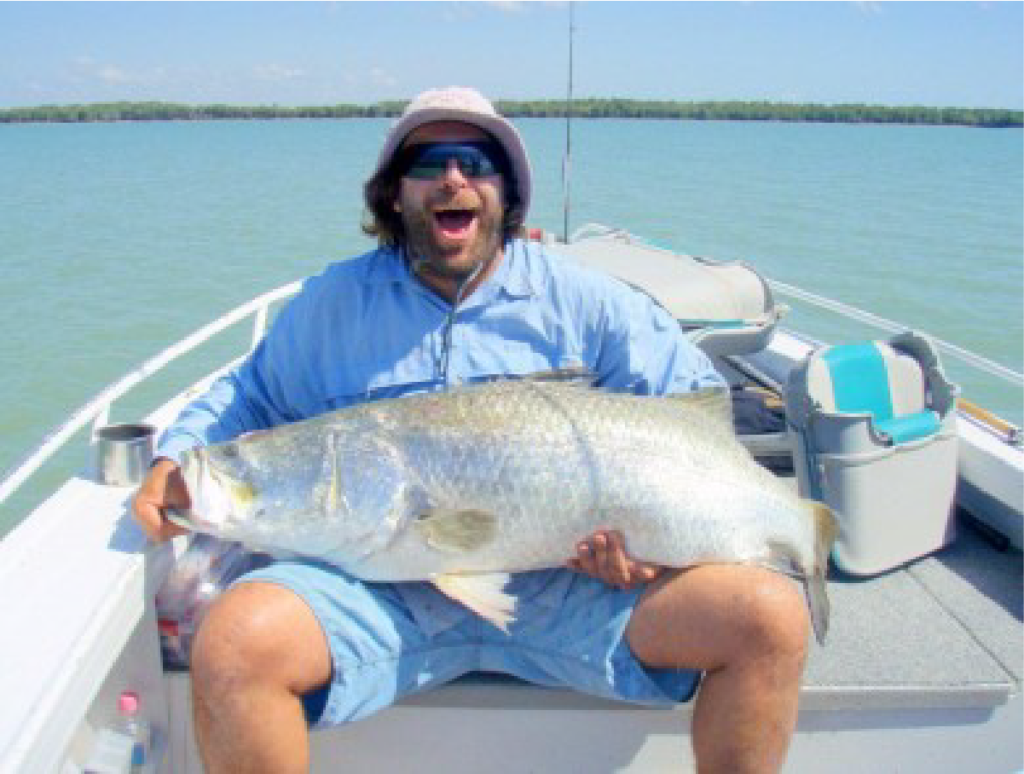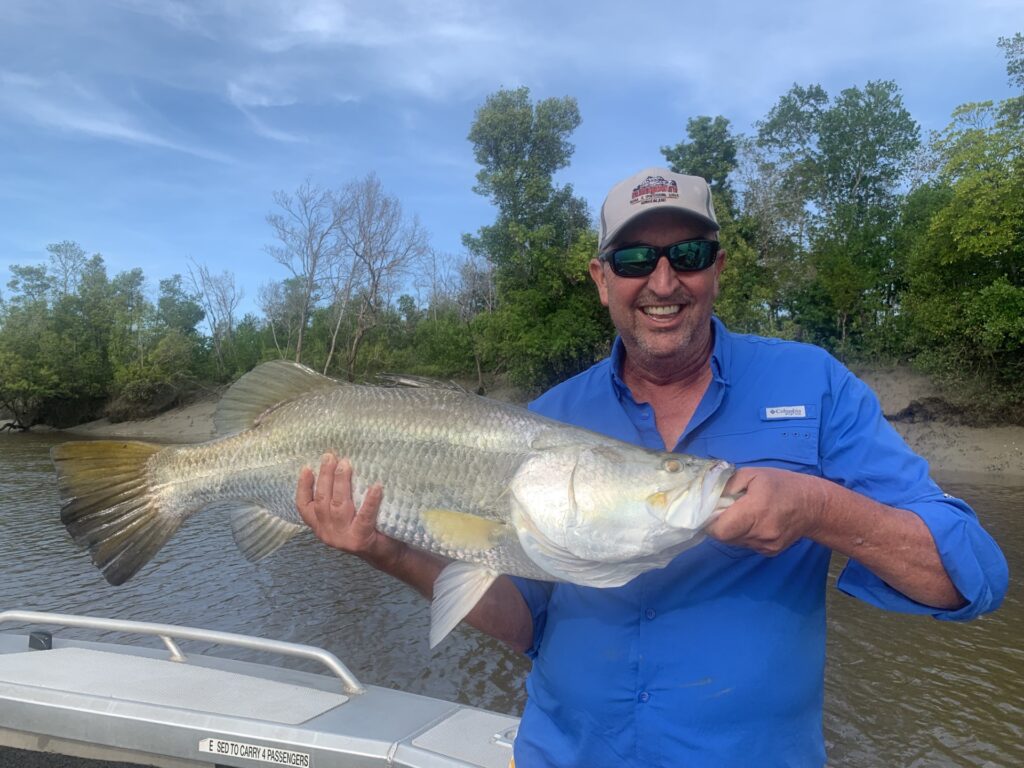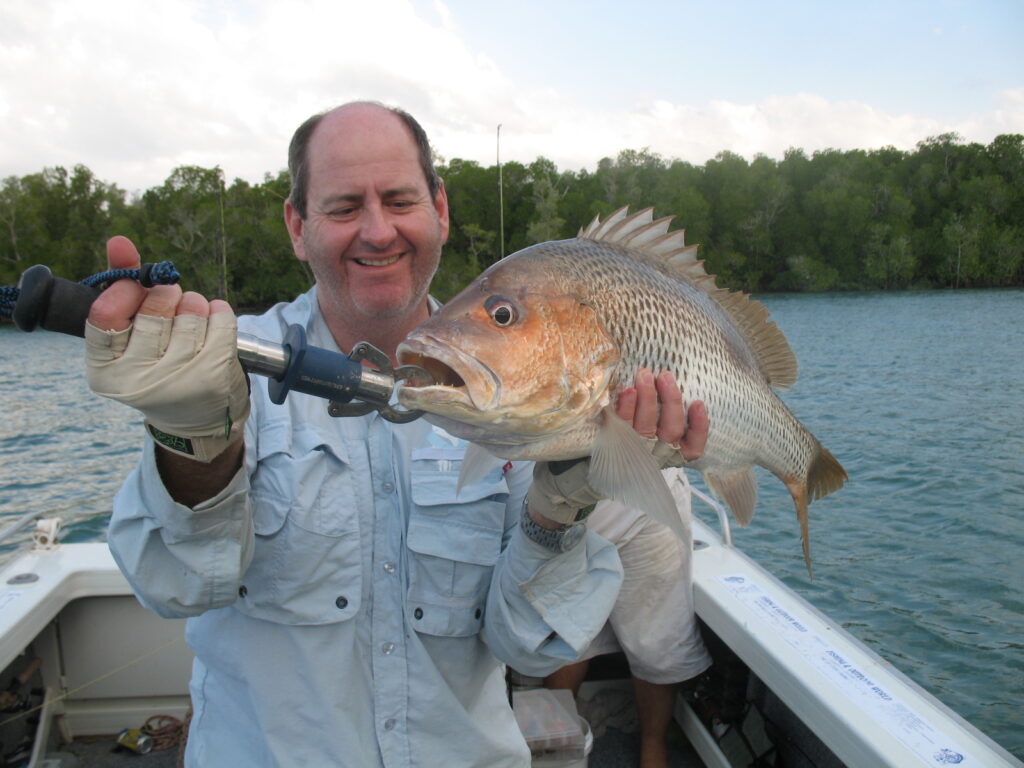Mini Mini River fishing
THE MAXI FISH OF THE MINI MINI
Destination Article on the Camp at Endyalgout Island and the Mini Mini River System.
Steve Starling wrote an interesting article in about November last year on his take as to which is the premier barra lodge in the country. Correctly, he pointed out that standing the test of time was something that few had managed to achieve, and that having water tight arrangements with the Traditional Owners for future years was essential for continued success. Steve’s choice was Arnhemland Barramundi Nature Lodge, which still sits on my wish list of destinations, but must be outstanding if he believes it tops a few other excellent choices, including the great lodge on Melville Island.
The same rules apply when it comes to remote fishing camps, and the set up at Endyalgout Island has cracked it’s 20th birthday and secured exclusive fishing rights to the surrounding river systems including The Mini Mini.

I’ve been fixated with the place since my first visit there in 1995, and have returned nearly every October since. From pretty basic beginnings, the camp has developed into a very comfortable base which compares favourably to similar operations, capable of catering for up to 12 on a 3 per boat basis.
I could give you a full description of the various structures that make up the camp but I’m going to pass on that till later and get straight to the fishing. It’s sensational. Whilst there are places that produce greater numbers, few could replicate the size and variety on offer here.
Barramundi
The Mini Mini System is synonymous with big barramundi and deservedly so. I’ve lost track of how many metre plus fish we’ve caught over the last 16 years but what’s been extraordinary is the number over 120cm including two behemoths of 130cm plus. Whilst the majority of large fish are taken on the troll during the neaps, the two largest barra we’ve encountered were both taken in the last couple years, casting shallow divers at drains a couple of hours before low tide. At 130 and 132 centimetres they’re huge fish to be hitting relatively small lures and getting airborne in shallow water.
Whilst there’s a great chance of cracking a metre fish on each trip, the majority are in the 50 – 80 cm range and taken casting at snags and structure or working the drains during the bottom half of the tide.
Having said that there are a couple of situations that are pretty unique and unbelievable fun.
The Enchanted Forest: As the full or new moon approaches and the tides get bigger, so do the variety of options. The last couple of day’s of the trip see the tides get to a level that when the barra retreat to the back of the mangroves, you can get in there and join them by bumping over, under and around the mangrove forest.
Basic rule here is spot a fish and you have casting rights. Nothing better than spotting a fish, delivering the impossible backhand cast in tight cover and hooking a bouncing barra with only a few metres of line between it and your rod tip. Most casts are no more than five metres so this is up close and personal fishing, where the fish aren’t big but the anticipation is huge.
The Green Room: As juvenile mangroves form in clusters, so do barra use them as one of their ultimate ambush points. Mangroves that stand as single stalks in tight proximity to each other provide the ultimate cover for barra to take advantage of. Casting shallow divers at the face of the “Green Room” provides a pound for pound strike that beats any other. Whilst this sought of opportunity only presents it self a few times a trip, the session normally lasts for a while and the power of the hit is what I look forward to each year.
The Traditional Options: There are literally hundreds of kilometres of rivers and creeks which are easily accessible to Endyalgout Island and provide a myriad of more traditional barra fishing options. These include trolling deep channels and sunken snags, working the drains as they empty into the main system, casting at and trolling around rock bars, skipping lures through colour changes, probing the shade and structure of established mangrove trees, the list goes on.


Like every barra destination there’s periods during each tide that can be slower than others, but the variety of options available here ensures they’re kept to a minimum.
Threadfin Salmon
I’m pretty sure it was one of the icons of the Northern Territory, the great Disco Buffalo (Wayne Ross) that first coined the phrase “wolf pack” in his days as a guide at Endyalgout. What he was referring to was huge schools of threadfin gorging on jelly prawns on the flats and in the drains feeding into the main system on the run out tide.
This is still a regular occurrence during the “warmer” months and there’s a heap of fish to be had on shallow divers, plastics and fly. Like any place where they’re feeding on jelly prawns, they can be a bit frustrating but perseverance normally wins out. On the other hand, they could be ravenous and belt just about anything you offer up. It’s amazing how many times you can see them rolling as they feed at the mouth of drains, and the first couple of fish you latch onto are barra before the whiskered ones kick into action. I can assure you the drains in the Mini Mini provide an enormous amount of action.
Golden Snapper/Fingermark
Who doesn’t love the brutal fighting qualities of the species that make up the Lutjanus Family. Goldies dominate these rivers and creeks and are present in sizes where you’d have expected them to have emigrated to deeper water and the offshore reefs. Our biggest to date is an 87cm specimen that weighed in at 8.5kgs and was taken casting at a snag on a Grey Ghost Manns 10+. About as close as you can get to black bass fishing without visiting PNG.
Fish above 55cms are a regular occurrence and a great target when other options are a bit quiet. The rock bars in the area also hold some big goldies where sizable estuary cod and juvenile queensland groper are a frequent bi-catch. All three pull pretty darn hard and put you to the test in any type of inhospitable terrain.
Whilst most of the goldies are taken on lures that dive to 3-4 metres, they find tremblers irresistible. The extra noise and vibrations given out by these sinking lures really gets their attention, and you can often hear them hitting the lure as it sinks past a rock bar or mangrove trunk.
Black Jewfish
Black Jewies are a reasonably common catch when trolling for barra. Some years they’re around in big numbers and most of them crack the metre mark. There’s a particular creek only ten minutes from camp which is pretty consistent when the wind conditions are right. What tough adversaries black jewfish are is pretty well documented, and the river dwelling version that frequents this area is no exception.
Blistering powerful runs which turn into a dogged tug of war really test out any barra outfit.
When you consider there’s a real chance of both metre plus barra and jewies whilst working some of the deeper channels of The Mini Mini, the concept that trolling can be boring goes out the window.
Queenfish
Whilst there’s the opportunity to head offshore and work a couple of islands which hold plenty of queenies, most of the larger fish are encountered on a high tide back up the rivers or at the front of Endyalgout itself.
Without warning you’ll spot a pair or a solitary queenie whilst casting for barra. They don’t hang round for long so it’s a case of placing a cast in their general direction with what ever lure you already had tied to the end of your line. Work it quickly and erratically and there’s every chance you’ll come up trumps.
The normal aerial antics follow, which for me is the best part of tangling with a big queenfish. They don’t pull as hard as a lot of the other species on offer, but nothing jumps higher, longer or more often. That silver sheen reflecting the overhead sun when they’re airborne is pretty spectacular viewing.
Other Species
Whilst barra, threadfin, golden snapper, black jews and queenfish make up the primary targets, there’s more on offer.
Trevally of both the golden and GT variety are common, a few juvenile queensland groper up to 20kgs are taken every trip along with plenty of estuary cod, blue salmon aren’t as plentiful as the threadfin but still about in good numbers and of a size bigger than I’ve witnessed anywhere else with the same going for the javelin fish in the area.
Jacks are scarce but well and truly covered by the abundance of goldies.
Mud Crabs
Muddies are around in good numbers most of the year. The guides take turns in setting and collecting half a dozen or so pots each day which normally produces enough for a pre-dinner crab feast washed down by a couple of cold ales. Always a great way to start the evening festivities.
How do you get there?
Endyalgout Island is situated about 200 kilometres east north east of Darwin on the Western edge of Arnhemland and is part of the Coburg Peninsula.
It’s about an hour flight from Darwin and on most occasions you land on a substantial salt pan situated literally at the back of the camp. Should wet weather determine the salt pan isn’t viable the flight diverts to Murgenella and it is then about an hour by 4 wheel drive and boat to the island.
When to Go?
This remote camp operates between May and November each year with the most comfortable weather being between June and August. Whilst you’re less likely to tangle with a metre plus barra, there’s plenty up to 80cm and a variety of other species to keep you entertained.
Like all tidal Top End destinations, the periods closer to the wet tend to be more reliable with May and September to November being the pick.
Tours are organised to coincide with the preferred moon phases being the half to full and half to new moon.



"The Mini Mini System is synonymous with big barramundi and deservedly so. I’ve lost track of how many metre plus fish we’ve caught over the last 16 years but what’s been extraordinary is the number over 120cm including two behemoths of 130cm plus. "


The Camp
The camp is situated at the rear of a picturesque beach within easy reach of the boats.
Guest accommodation is made up of four safari style tents situated on raised timber floors which are fully insect proof. There are three single beds in each tent, lighting and fans.
Common areas include a substantial mess area with indoor and outdoor under cover dining and lounge areas. The kitchen is incorporated in this area.
Flushing toilets and showers with great water pressure are in a separate building.
It’s pretty unique to have a set up where you can land light aircraft a couple of minutes walk from camp and the boats are moored on the beach where the camp is situated. This certainly minimises any mucking around and maximises time spent fishing.
The Guides
In the twenty odd years that Endyalgout has been running it’s boasted a very impressive list of guides including the likes of Barra Classic champions Wayne “Disco Buffalo” Ross and Trevor Robb, as well as several of the Top End’s other leading operators.
John “The Guru” Dagan has the lease and rights to exclusively fish the surrounding rivers and creeks and I rate him as one of the top guides I’ve had the pleasure of fishing with in the nearly twenty years I’ve been heading to the NT. Local knowledge is important and John employs the services of independent guides who have fished the area on numerous occasions. Most have been sub contracting to John and fishing the Mini Mini for some time.
Tackle Recommendations
I like to work with two outfits, one which is light enough to be able cast all day and the other set up for whatever trolling we might do.
My preferred casting combination comprises a G-Loomis 3-5kg Forcelight matched up with a Shimano Curado strung with 20lb Finns braid. Most of the genuinely big barra you’re likely to encounter whilst casting will come from drains towards the low tide, so there’s not too many situations where you need to crank up the drag to stay out trouble. The test comes when a jumbo sized golden snapper takes your offering in close to whatever structure you’re casting at, already heading for home. The odds swing against you in this scenario but the victories are sweet.
Most of the other species you’ll encounter can be handled, with the exception of the occasional juvenile queensland groper or big estuary cod.
The trolling outfit gets a lot less use but accounts for most of the larger fish. For this I stick with Shimano with the real being a Calcutta 300TE matched to a compatible T-Curve. Line class is upped to 30lbs. You’re trolling in close to or over structure so that bit of extra grunt makes all the difference.
Lures
I’m hopeless when it comes to minimising the number of lures I take on any trip, hence the nickname, “Capt Tackle”. I probably only use ten percent of what I cart to places like this but convince myself I need to be prepared for any possible scenario and that I’m going to lose more lures than I ever do.
Surface lures: Work a treat in the “Enchanted Forest” and over the flats where small mangrove roots can be a nuisance. Skitter Pops and the Tango Dancer in the medium to large sizes will cover all your surface needs.
Shallow Divers: You’ll probably be flicking one of these more often than anything else. Yes, the Gold Bomber and a couple of colour variations in the same lure produce, but if there’s a bit of breeze a couple of the Japanese options have superior casting qualities and a great action. My preference here is the Saruna 125F in either a pearl or gold colour. Throw a couple of Reidy’s into the mix and you’ll have things covered.
Mid Depths: Needed to cover both the deeper casting and shallower trolling options. Barra Classics in both the 10+ and 15+ are a must. I still have a real liking for the Manns 10+ in the Grey Ghost pattern which over the years has been a “go to” lure for me and seldom let me down.
Deep Divers: “The Guru” loves his Storm Lures for trolling the deeper parts of the Mini Mini, especially the orange and yellow version. This produced the two largest barra of our 2010 tour. The deeper Barra Classics and RMG Scorpions have produced plenty of metre plus fish and are great on the black jewfish
There’s another group of a dozen keen fisher folk heading back to Endyalgout in October this year. On each return visit the camp keeps getting better and the fishing stays consistent. I know there are plenty of great Top End destinations to choose from and I put this one up there. Cost wise Endyalgout compares favourably with similar destinations and certainly provides the variety and quality of fish that’s hard to replicate anywhere else.

